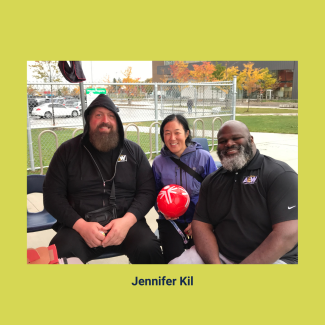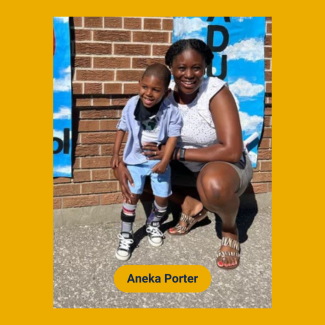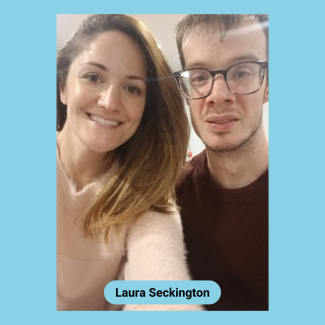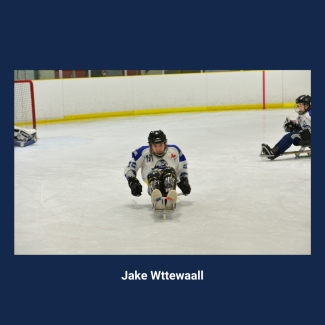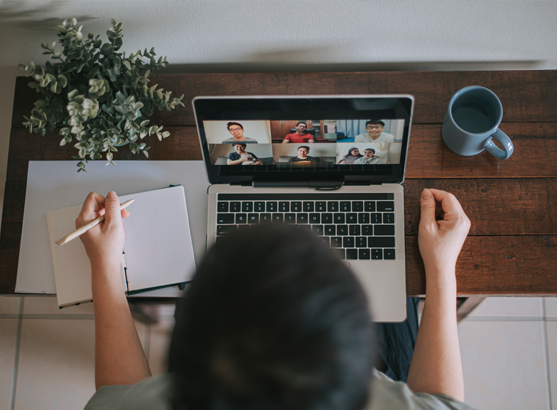
On October 18, 2022, Ophea hosted a panel discussion webinar to address some of the common themes educators face when teaching students with disabilities. Ophea’s new resource Disability-Centred Movement: Supporting Inclusive Physical Education was launching just a few days later, and the webinar served as a timely opportunity to start the conversation about disability with a fellow panel of unique contributors.. With an open Q&A panel discussion moderated by Ophea’s Health and Physical Education Curriculum Consultant, Andrea Haefele, the participants who joined were able to ask their own questions as the panelists presented their views and knowledge of disability.
We would like to thank Ontario Parasport Collective and the Ontario Trillium Foundation for their partnership and support for the development of this resource and the delivery of this webinar. In addition, we thank the panelists for sharing their expertise and lived experience with our audience:
- Jennifer Kil is a secondary Health and Physical Education Teacher who teaches and coaches students with different needs, recently adapting the Recreation & Fitness Leadership course (PLF4M) so that students can work collaboratively in a physical education setting with students with developmental delays.
- Aneka Porter is a Child & Youth Worker and advocate for health and well-being for elementary students and their families. She has a son with a disability and has recently begun to experience the school system from a parent/guardian lens.
- Laura Seckington is a Special Education Teacher specializing in teaching students with Autism Spectrum Disorder. Laura is an advocate for inclusion with an interest in Physical Education, and also has a sibling with a disability.
- Jake Wttewaall is a Youth Advocate currently attending Seneca College for engineering. He has cerebral palsy and hereditary spastic paraplegia, and is an advocate for youth with disabilities in education and sports.
Access the full webinar on our YouTube channel.
It is our pleasure to share this Ophea platform with Laura Seckington. Laura’s experience includes teaching at both the elementary and secondary levels with students with complex needs in both classroom and treatment settings. She has taught for 12 years in environments specific to children with Autism Spectrum Disorder, and spent two years working on an Interdisciplinary Team assisting school staff with students with behaviour needs and working for the Crisis Prevention Institute as a trainer. She has a background in Applied Behavioural Analysis, and her passions include advocating for the inclusion of students with disabilities whenever possible.
Laura has been involved in Ophea’s inclusion work through the provision of her expertise and guidance as an expert working with students with disabilities. Most recently, we reached out to Laura for support in developing our newly launched resource, Disability-Centred Movement: Supporting Inclusive Physical Education and to provide a summary of and her reflections on each of the three themes discussed on the Disability at the Forefront: Q&A Power Panel.
Theme 1: Know Your Learner
Belonging is essential to well-being, and well-being is essential to learning.
– Every Student Can Thrive: Ophea’s Equity-centred Strategy for Well-being in Ontario Schools, Ophea
We all think we know a lot about the students we teach, including those we have taught year after year, those whose siblings we have taught, or those who enter our classroom with memorable quirks, interests, or special skills. We will flip through the Ontario Student Record if the need arises, but generally get to know our students through everyday classroom activities and conversations. When teaching students with disabilities, we need to know our learners on a different level, and cannot rely solely on face value presentation or what we read on a student profile. Like all students, much lies beneath the surface of someone who is living with a visible or invisible disability. This is why the Individualized Education Plan (IEP) exists as a tool to help bridge the gap between what we know about a student’s background, the goals they need to achieve, and how they will achieve them with student-specific accommodations and support. If you are currently teaching a student with a disability in your class, you need to read and be familiar with the information in their IEP. Furthermore, as their Health and Physical Education Teacher, you will be asked for input on student goals and accommodations relevant to your subject area.
The panelists in our session shared what “knowing the learner” means to them. For Jennifer, it involves finding out common interests even amongst reluctant learners. For Aneka, it means valuing the role of the Child and Youth Worker and the rapport that is built within and outside the classroom walls.
As a student with a disability, Jake found the best way to connect with his teachers was actually having a say in what he was learning, how he was learning it and how he could be most successful. In my work consulting and working with educators looking for help with integrating students with disabilities into their classrooms, most are seeking the HOW. How do I change my programming to meet the physical needs of a student? How do I think of a way to assess this student differently, and fairly? As Jake reiterates, it starts with a simple conversation. If your student is non-verbal, speak to those who know them best, such as parents/guardians or a support staff.
“Expressing my feelings about something I enjoy helps me feel like I belong. For example, being able to talk to the teacher and [helping them] understand any adjustments so I [can] have more participation in the activity.” - Jake
Jake’s comment prompted me to comment on ways to not only advocate for students, but to teach students to help advocate for themselves. I thought about students traveling from teacher to teacher in a secondary school setting, and how the use of a simple advocacy card can be a discreet and highly effective way to share information about the student and what accommodations they need to learn best. An advocacy card is a great way to bridge the gap of unfamiliarity between a new student and/or teacher, and can spark meaningful conversations between the two.
Theme 2: Collaboration
As a teacher in a partially-integrated classroom, I am well-versed on the importance of working collaboratively as a team. In fact, there are some days where there are more adults than students in my classroom, and I rely heavily on a team to support programming, safety, communication, and our daily routine. My students travel to Physical Education where they are integrated into a class with students without disabilities, and are taught by a teacher where I am not present. While I work during my elusive and sacred “prep time” and plan in another area of the school, I have a sense of trust that my students are learning to the best of their abilities while gaining valuable social skills with another teacher and group of students. Like all relationships, those between students and teachers take work, respect, and communication. I find time to communicate with the Health and Physical Education teacher, offer support, and reflect with them on what is going well and the challenges they may face. Aneka addresses the theme of collaboration with staff members with a positive anecdote, and mentions a team she worked with who valued sitting down at the end of each day, even for five minutes, to discuss their students’ highlights and challenges:
“We stayed, debriefed and shared the strategies that we used with certain students, and this made me feel part of the team. Just as students want to feel a sense of belonging, we need to create [this same] atmosphere amongst staff as well.” - Aneka
Jennifer discusses her role as a secondary teacher in a Leadership and Fitness Recreation course (PLF4M), which she has designed in a unique way to promote disability-awareness and inclusion in her school. In this particular course, grade 12 students collaborate with the school’s 6 self-contained classes of students with disabilities to work together in a Physical Education setting. Sometimes the leadership students are partnered up to teach those with disabilities and sometimes they are competing together in events such as the Special Olympics Ontario Unified Program, where both sets of students are playing together regardless of ability level. Jennifer’s inspiring program truly shows limitless opportunity and potential for all students involved, and her passion for its success is evident.
“The students without disabilities are actually learning from the students with disabilities…they walk away every single day going ‘I can’t believe what I just witnessed’…they want to have lunch with their partners!” - Jennifer
Jennifer’s successful program would not be possible without collaboration between her disabled and non-disabled students, which is a partnership that undoubtedly takes weeks and weeks of modelling, and relationship and compassion building at the beginning of each term. Similarly, I have experienced this collaboration at the elementary level, where I have had to find ways of teaching students as young as kindergarten how to interact with peers who may not act, speak, or socialize in the same way as they do. Luckily for us, and for Health and Physical Educators, body language and movement is a universal language where students can demonstrate their learning in a number of ways, and allows educators to think outside of the box of the “right way” to exhibit and assess physical skills.
Theme 3: So what? …Now what?
Questions began to flow into the Zoom chat and all presented a similar, overarching theme: How can we empower students with disabilities in and out of school? Yes, the “how” is what educators search for most, and I think that in order to know the how, you need to see it in action. It is important for educators to see classes, programs, and partnerships where integration and inclusion is working. How can we make this happen within our busy schedules and mile-long lists of to-do’s? Start small. Check out Twitter and start following Physical Education teachers who are currently making things work. Connect with like-minded Physical Education teachers and activity providers in your area or your network of schools to collaborate on an intramural or leadership program that could be run to foster inclusive spaces in your classrooms. Read articles from authors, educators, and researchers like Shelley Moore, who continue to dive deep into the realm of disability justice and what it can look like in the education setting if we keep it as a forethought, and not an afterthought, in our lesson plans.
Jake talks about wanting to be on the football team and finally finding success, not as a player, but as a coach. It was an exciting moment for him where he was able to share his knowledge with peers without disabilities and be included in the game, though not in the traditional sense. Aneka encourages educators to have a growth mindset and recognize that change takes time to happen, and that trial and error is sometimes necessary to find something that works. I, too, recognize that my classroom has changed over time and continues to change yearly and even monthly with the same set of students.
Now that we know what a successful teaching environment for students with disabilities can look like in Physical Education, how do we know if we’re doing it right? Our panelists had some closing thoughts:
“The environment evolves with the students and their unique needs. Celebrate the successes, no matter how small.” - Laura
“Support from teachers - knowing that somebody is behind you giving you a push forward, it makes a huge amount of difference in your day and your experiences” - Jake
“Students with and without disabilities are all actively engaged in Physical Education…are the student’s goals being met? We need to analyze and ask ourselves these questions and go back to the Individual Education Plan” - Aneka
“Teachers are advocating for students to have gym times, access to [physical education] and opportunities to be engaged. We are growing slowly but we are getting there!” - Jennifer
Ophea is looking forward to their newly launched Disability-Centred Movement: Supporting Inclusive Physical Education resource gaining traction and beginning to spark meaningful conversations and action between all partners in education.
The Disability-Centred Movement: Supporting Inclusive Physical Education resource defines inclusion as both a process and a goal, and helps educators navigate through building a successful Physical Education program that is designed to meet the needs of every student. From the Individual Education Plan (IEP) process to exploring program settings with an informative glossary for reference, this resource is an essential bookmark on any Physical Educator’s taskbar. Disability-Centred Movement: Supporting Inclusive Physical Education provides educators and community partners with the WHAT, the WHY and the HOW of teaching students with various disabilities in Physical Education.
- WHAT does teaching students with disabilities in various learning environments actually look like?
- WHY is it beneficial to offer a variety of accommodations and setting options for different disabilities in the Physical Education environment?
- HOW does an educator navigate the student’s Individual Education Plan and actually implement accommodations and modifications into their daily teaching practice?
Ophea thanks Laura for this fantastic recap of our Disability at the Forefront: Q&A Power Panel, and all of our panelists for their essential contributions and perspectives. Be sure to connect with us and share your successes in creating an inclusive program for your students with disabilities by tagging @OpheaCanada on Twitter, Facebook, and Instagram.
To stay up-to-date on Ophea professional learning offerings, resources, and supports sign up for Ophea’s e-newsletter, eConnection.

